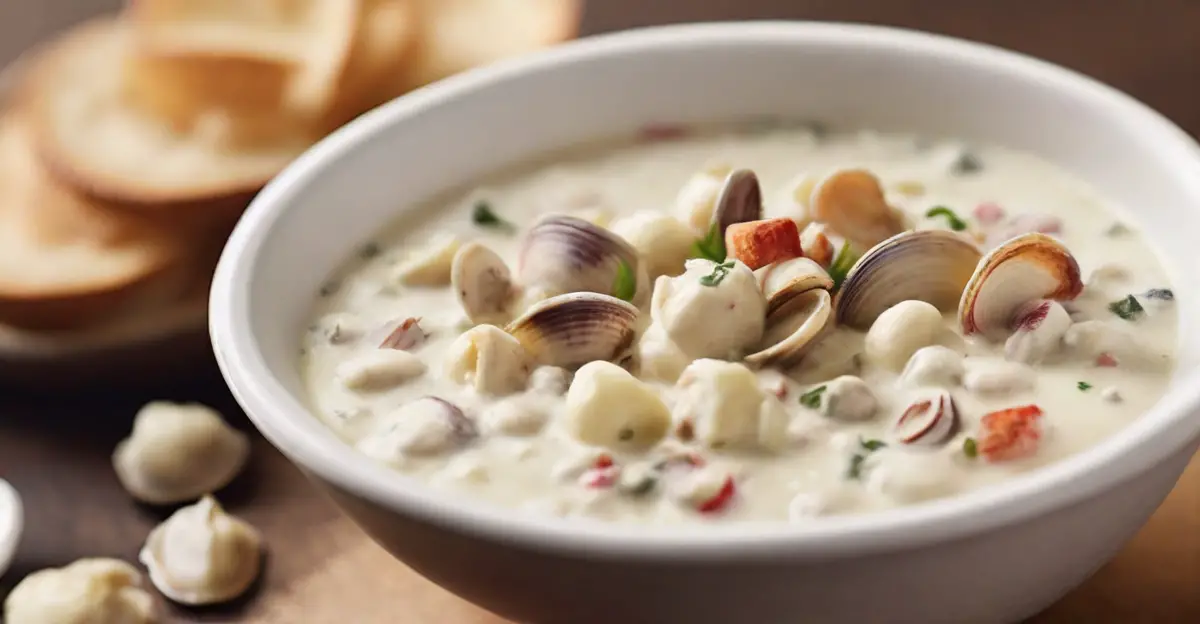As a passionate home cook who has explored the rich and hearty world of clam chowder, I’ve discovered that this beloved seafood soup is more than just a combination of clams, broth, potatoes, onions, and celery. Originating from the eastern coast of North America, clam chowder has become a popular dish, steeped in regional variations. The New England-style, known for its cream-based approach, and the Manhattan-style, with its distinctive tomato-based flavor, are among the most celebrated.
While home cooks often enjoy the process of preparing and simmering these vegetables and seafoods, resulting in a flavorful meld of tastes, an important aspect to consider is its shelf life. The addition of cream or milk lends this soup a luscious, thick consistency that is particularly comforting on cold or rainy days. But how long does this delightful concoction last? The key lies in its storage. When stored properly in the refrigerator, clam chowder retains its quality, ensuring that every spoonful remains as delectable as when it was first simmered.
How long is clam chowder good for?
Expiration & Storage Tips
When it comes to the beloved clam chowder, whether it’s canned or homemade, understanding its lifespan is crucial. For instance, once you’ve opened a can of clam chowder, it’s best to keep it refrigerated and consume within 3 to 4 days to maintain its optimal flavor and quality. As someone who has experimented with various recipes, I’ve learned that homemade clam chowder, brimming with freshness, should ideally be consumed within 2 to 3 days of making it. The flavors tend to deepen, making each spoonful a delightful experience.
Preserving Unopened and Frozen Chowder
On the other hand, if you didn’t open your canned soup, the ‘best by’ date printed on the can is your guide. Typically, this date ranges from 2 to 5 years from the production date, assuring you of the soup’s integrity over a considerable period. For those who love to plan ahead, freezing clam chowder can be a practical option. When properly stored in the freezer, clam chowder can last for about 4 to 6 months. Thawing and reheating it correctly can bring back the cozy warmth and rich taste, making it a convenient and comforting meal for any day.
Practical Insights for Chowder Lovers
As a connoisseur of clam chowder, I recommend always paying attention to storage details. Whether refrigerated or frozen, ensuring your clam chowder is stored correctly can extend its shelf life, allowing you to savor its rich, creamy goodness whenever the craving strikes.
How do you tell if Clam Chowder is bad?
Determining if your clam chowder has gone bad involves a bit of sensory investigation. Smelling and looking at the chowder are the first steps. An off smell is a clear sign that the chowder shouldn’t be consumed. When I open a pot of clam chowder, I expect a fresh, oceanic aroma. If what greets me is anything but, I know something’s amiss. Similarly, the appearance of the soup can also be a great way to tell if it’s spoiled.
In my experience, clam chowder that’s past its prime might show mold, or its texture could change, becoming watery or slimy. Another giveaway is the presence of an off color, particularly a darker shade than usual, which can be an indication of spoilage. These visual and olfactory cues are crucial, as they apply to all foods. If there’s ever a doubt, it’s better to err on the side of caution and throw out the chowder. It’s a small loss compared to the risk of consuming spoiled food.
Tips for storing Clam Chowder to extend shelf life
Ensuring that your clam chowder stays fresh and delicious involves a few key storage strategies. First and foremost, always seal your chowder in an airtight container. This is essential whether you’re storing it in the fridge or the freezer. I’ve learned that this simple step can significantly prolong the shelf life of the soup. When it comes to freezing, I recommend portioning the soup into individual servings. This way, you only defrost what you need, maintaining the integrity of the chowder.
In terms of defrosting, the best method is to transfer the frozen chowder to the fridge and let it thaw overnight. This slow thawing process helps preserve the chowder’s texture and flavor. Using the defrost function on your microwave can also work in a pinch, but be cautious not to overheat it.
Another tip, especially for homemade chowder, is to cool it quickly before storage. This helps to slow the growth of bacteria. You can achieve this by placing the pot in a bath of ice water and stirring the soup. Lastly, try to avoid reheating your clam chowder multiple times as this can degrade its texture and flavor. These small steps can make a big difference in keeping your clam chowder tasting as good as the day it was made.
WHAT ARE THE DIFFERENT TYPES OF CLAM CHOWDER?
When discussing Clam Chowder, it’s essential to recognize the difference between its various varieties. The most common and popular type is the Boston Clam Chowder, which boasts a rich, creamy base typically made with potatoes, onion, and clams. In my culinary adventures, I’ve found that this variety’s thick texture and hearty flavor make it a comforting choice, especially on chilly evenings. Interestingly, in 1939, a bill was introduced in the Maine legislature proposing to make adding tomatoes to this style of chowder illegal. Although it didn’t pass, it highlights how seriously this chowder is taken!
Another well-known variant is the Manhattan Clam Chowder. Contrasting sharply with its Boston counterpart, it features a clear tomato broth and is essentially a vegetable soup with clams. The tomatoes give it a tangy zest that’s quite different from the creamy Boston style. This variety is especially popular among those who prefer a lighter, broth-based soup.
As a chef and chowder enthusiast, I’ve come to agree that each type of clam chowder offers a unique experience. Whether you prefer the lusciously creamy Boston version or the lighter Manhattan style, clam chowder remains a versatile and beloved dish.
CAN I MAKE CLAM CHOWDER AHEAD OF TIME?
Absolutely, making Clam Chowder ahead of time is not only feasible but can also enhance its flavors. In my own kitchen, I’ve noticed that clam chowder often tastes better the next day. As it stands overnight in the refrigerator, the ingredients meld together, enriching the overall flavor profile. This makes it a fantastic choice for leftovers or when planning meals for busy weeks.
However, it’s important to note that clam chowder tends to thicken as it cools. Before reheating, I typically whisk in a little milk to restore its original consistency. This small step ensures that the chowder remains creamy and delicious, just like when it was first made. Remember, whether enjoying it fresh or the next day, clam chowder’s comforting warmth and rich taste are always a delight.
CAN I FREEZE CLAM CHOWDER?
Freezing Clam Chowder is a topic that often stirs debate among culinary enthusiasts. From my own experience in the kitchen, I generally do NOT recommend freezing this particular type of soup. The primary issue with freezing cream-based soups like clam chowder is the way the fat content reacts to the freezing process. It tends to separate when frozen and then defrosted, which can drastically alter the soup’s texture and flavor.
Another consideration is the ingredients, particularly the potatoes. In clam chowder, potatoes are essential for their hearty texture. However, when frozen and then defrosted, they can become mealy and mushy, losing their appealing texture. This change can detract from the overall quality of the soup, making it less enjoyable than its fresh counterpart.
Despite these challenges, if you find yourself with an abundance of clam chowder and freezing seems like the only option, there are ways to mitigate these texture issues. Thawing the chowder slowly in the refrigerator and stirring it well during reheating can help to some extent. But it’s crucial to remember that the thawed soup might not fully recapture the wonderfully creamy, hearty, and satisfying qualities of a freshly made batch.
When you dig into a bowl of better-than-any-restaurant Clam Chowder, seasoned to perfection, you want the experience to be memorable. The creamy texture, the rich flavors, the perfect seasoning – all these elements contribute to why we love this dish. So while freezing is possible, it’s best to enjoy clam chowder fresh, when it’s prepared to deliver that blown away moment we all crave.
FAQs
How do you know if clam chowder has gone bad?
Clam chowder that has gone bad will often have an off smell, mold, or a watery or slimy texture. It might also change in color, typically becoming darker.
How long can clam chowder last in the refrigerator?
Opened clam chowder can last in the refrigerator for 3 to 4 days. If it’s homemade, it’s best consumed within 2 to 3 days.
How many days is chowder good for?
Chowder is generally good for 2 to 4 days when stored in the refrigerator. This timeframe varies depending on whether it’s homemade or store-bought.
Is it OK to eat expired clam chowder?
It’s not advisable to eat expired clam chowder, especially if it’s well past the ‘best by’ date. Doing so may increase the risk of foodborne illness.
Can you eat clam chowder every day?
While clam chowder can be part of a balanced diet, eating it every day might lead to excessive intake of certain nutrients or additives, depending on the recipe. It’s best enjoyed in moderation.

